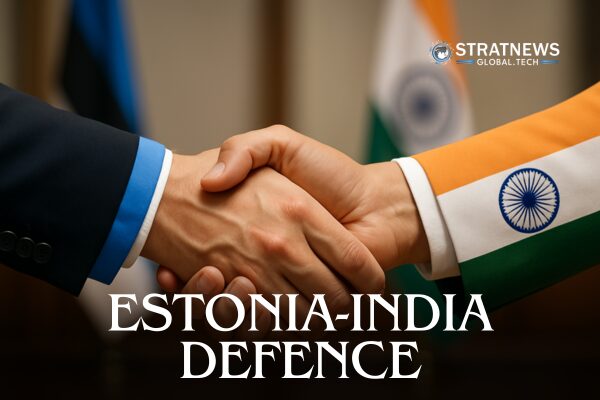Estonia, a key member of NATO, aims to establish itself as a significant defence partner for India. The Baltic nation is actively seeking investments for its large defence industrial parks while encouraging its private sector to collaborate more closely with Indian defence firms. Currently, Estonia is in discussions with the Indian Army regarding the sale of unmanned ground vehicles (UGVs).
Owing to the ongoing war between Russia and Ukraine, Estonia is planning to significantly increase its defence spending to up to 5.4 percent of its GDP by 2026. Last year, it had announced a mega defence industrial park spanning up to 100 hectares, that would have an ammunition plant and explosives handling facilities.
“Estonia is not a big country but we want to be bees, which can paralyse an elephant … We need to be smart, quick and more precise as your enemy and that means you need to bring more smart tech and new solutions onto the battlefield,” said Hanno Pevkur, Defence Minister of Estonia.
Speaking to StratNews Global in Tallinn, he said several Indian defence firms have shown interest in investing and setting up manufacturing units in their upcoming defence industrial park, which is going to come up in Pärnu County, which sits at the mouth of the Gulf of Riga, being built at a cost of Euros 50 million. The first production facility there is going to be operational by 2027.
He also said as many as 12 defence companies have shown interest to invest in the park, of which some are from India.
“I cannot name any company at the moment … But I can say that the connection between Estonia and India are growing. Estonia and India are very similar,” he told SNG, adding, Estonia is looking to diversify its defense production and reduce its reliance on a single supplier, particularly in ammunition manufacturing, where Indian companies are showing interest.
Estonia has been a member of NATO since 29 March 2004.
The country’s private sector, on the other hand, is looking to substantially increase joint collaborations and defence industrial partnerships with India. With a focus on ramping up business-to-business ties, Estonian defence firms are seeking joint collaboration in the areas such as radar technology, ammunition production, and cyber security.
Kaimo Kuusk, Permanent Secretary General of Estonia’s Ministry of Defence, said the country is looking for co-production offers from Indian defence firms. He also said Estonia is looking at exporting defence items to India.
Estonian UGVs for India?
As of now, the Estonian government is pushing their private sector to offer a range of products to India that are battle tested. One such item is an unmanned ground vehicle (UGV) produced by Milrem Robotics, headquartered in Tallinn.
“Milrem Robotics’ unmanned technology is combat-proven in the Ukraine war (against Russia) and is ready to be deployed anywhere in the world,” Paul Clayton, Director, Industrial Partnerships, told SNG, adding that they are in talks with India for offering UGVs to the Indian Army.
“The talks are currently at an early stage. They (Indian Army) have made some requests for the products they are looking for unmanned ground vehicles. We are in the stage of finalising which one. TheMIS vehicle meets 90 per cent of their requirements,” he told SNG.
THeMIS is an advanced multi-role defence platform designed for various operational tasks. The company has a wide range of UGVs – THeMIS, HAVOC, VECTOR, Type-X and Autonomy.
THeMIS is currently used by the armed forces of as many as 20 countries including the UK, US, France and Germany.
“The next stage for now will be to find a partner (in India) with whom we can engage and take the deal forward to seek this opportunity,” said Clayton, a former colonel in the British Army.
“If you have the capability of UGVs and have surveillance as well as having an offensive capability, then that acts as a big deterrent for anyone coming forward. Because, these things don’t sleep, they are always alert and it’s very difficult to be able to counter that.”
UGVs cann operate in a range of environments, from deserts to mountains but it cannot operate at very high altitudes.
“This will not replace soldiers. There is always going to be a human element on the battlefield. But we can enhance combat power by using robots that will potentially reduce the risk of life and enhance capability.”
According to Clayton, robots are going to significantly change the modern-day battlefield, with UGVs for one, replacing personnel in direct combat thereby reducing the risk of injury or fatality in hazardous environments.


